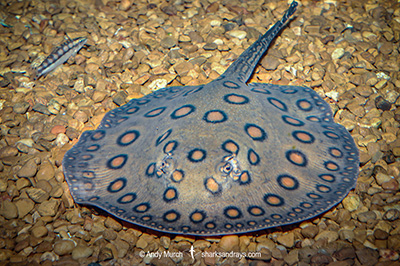Common names
Amanda’s River Stingray, Amanda’s Freshwater Stingray.
Binomial
Potamotrygon amadae.
Synonyms
None.
Identification
A medium-sized freshwater stingray with a sub-circular disc that is slightly longer than wide. Small, often indistinct lobe on tip of snout. Eyes relatively large and protruding. Spiracle large and trapezoid. Length more than 2x orbit width. Nostrils thin. Nasal curtain narrow and deep. Mouth narrow with 5 oral papillae. Labial grooves well developed.
Disc broadly covered in small denticles; denticles largest towards centre of disc. Pelvic fin posterior margins protrude slightly beyond pectoral disc margin. Tail fairly thin with well developed dorsal and ventral fin folds at tip. Tail shorter than disc width, with 1-3 rows of thorns on midline, beginning anterior to tail base. 1-2 rows of small lateral thorns present. Caudal stings positioned distally at end of tail.
Colour
Dorsum light grey or dark brown, with small yellowish or white spots/ocelli ringed in black. Black outer ring may be indistinct. Spots concentrated centrally on disc; absent from disc margins. Ventrum mostly grey. Tail covering with small irregular white spots, dark posteriorly.
Size
Maximum disc width 65cm. Size at birth 15cm dw.

Conservation Status
LEAST CONCERN
Amanda’s River Stingray (Potamotrygon amandae) is collected for live export in aquarium fish trade. It is also caught by subsistence fishermen and consumed locally. When discarded, it is often intentionally killed or its tail mutilated.
However, due to the recent damming of rivers, which has removed certain natural barriers that previously restricted its range, Amanda’s freshwater stingray is expanding. It appears to adapt well to new environments and may pose a threat to naturally occurring species. In some areas such as the Upper Paraná Region in southeastern Brazil, it is now considered an invasive species.

Habitat
Tropical freshwater lakes and river systems.
Distribution
South America. Amanda’s river stingray naturally occurs in the lower Paraná-Paraguay Basin, mainly in the lower drainages of the Santa Fé Region. Since the instalation of the Itaipu Hydroelectric Dam in the 1980’s, Amanda’s river stingray has been able to move upriver beyond a series of (now flooded) waterfalls known as Sete-Quedas de Guaíra, subsequently colonizing the Upper Paraná sub-basin where it is considered an invasive species.
Reproduction
Viviparous. 1-3 pups per litter.
Diet
Diet unknown, but probably consists of insects, molluscs, crustaceans, and small fishes.
Behavior
Amanda’s river stingray segregates by size with smaller individuals preferring shallower beaches less than 4m deep and larger animals staying in deeper water ~8m, moving into shallower water at night to feed.
Reaction to divers
Fairly easy to approach with non-threatening movements. Moves away when closely approached.
Diving logistics
I have photographed Amanda’s river stingrays in the Rio Salobra. Apparently this ray is relatively common in Northern Argentina in the Rio Corrientes.
What’s new
View our full list of updates
Similar species
Ocellate/Peacock River Stingray. Distinguished by smaller spiracles and pattern of tri-coloured occelli consisting of large orange/yellow spots with white centres and black outer rings.




